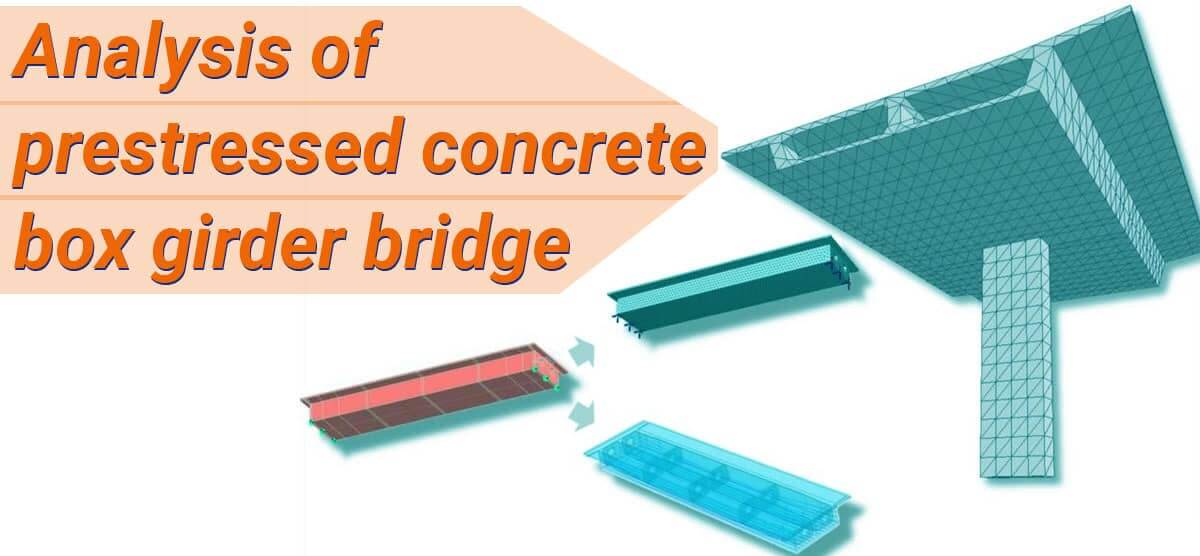Analysis of Prestressed Concrete Box Girder Bridge
TweetA bridge is a structure built to cover a physical obstacle, such as a body of water, valley, or road, without closing the way underneath. It is constructed for the purpose of providing passage over the obstacle, usually something that is otherwise difficult or impossible to cross improving its connectivity with other places thus improving trade and economy.
Introduction:
Prestressed concrete combines high strength concrete with high strength steel in an " active " manner. This is achieved by tensioning the steel and holding it against the concrete, thus putting concrete into compression. This active combination results in a much better behaviour of two material.
Studies show prestressed I-beam girders have the longest service life and require less maintenance. Prestress girder type bridges gaining popularity because of its better stability, serviceability, economy, aesthetic appearance and structural efficiency. Prestressed concrete bridges mostly came into used because of their rapidity, ease of construction, and competing in costs with other alternatives such as steel and reinforced concrete.
What are the advantages of prestressing?
Prestressed concrete consists of eliminating the traction forces of the concrete by introducing artificial compression tensions before applying the exterior loads and assuring that, when superimposed, the total permanent tensions should lie between the limits which the material can bear indefinitely. The use of this technique in building all kinds of architectural and engineering projects is today unquestionable and completely standardised thanks to its great benefits.
The principal advantages of prestressing concrete in construction are the following:
STRUCTURAL STRENGTH
The use of the prestressed technique in concrete gives it more strength, by providing an internal compression force which counteracts the traction force produced by the loads of the structural elements.
DURABILITY OF THE CONSTRUCTION
Prestressed beams aids in the elimination of cracks from all of the load stages. This absence of cracking supposes the structure's greater capacity to withstand loads, impacts, vibration and knocks, while minimising the possibility of corrosion in the steel, thus increasing the durability of the construction.
COST-EFFECTIVE
The use of the tensile concrete allows for large spans in construction due to the length of the pieces, while providing saving in material and greater lightness. We find an example of this in the use of tensile prestressed beams for enclosing large spaces, such as industrial warehouses, while providing greater luminosity.
DESIGN
Prestressed concrete pieces give more efficient and beautiful architectural elements, while providing infinite possibilities in construction.
The serial production of prestressed beams and hollow core slabs are giving solutions to all of the phases of the process which allows greater quality control, cost reduction and high production, hence solution to large architectural projects.
RAPIDNESS IN CONSTRUCTION
Faster construction by attacking various fronts at the same time or building different parts of the structure simultaneously. This generally gives significant economic benefits in a full economic and financial analysis of the work.
Types of Prestress Girders and its Purposes:
In superstructures like concrete bridges most common forms used is precast girders with cast-in-situ slab. This type of superstructure is generally used for spans between 20 to 40 m. Majority of prestress concrete bridges, are post tension type.
Different types of girder bridges are namely as,
- Cross section of T-Girder with cast in situ deck
- >I-Girder with cast in situ deck
- Box girder with cast in situ deck
The methods for the analysis of box girder bridges are as follow
- Simple line analysis or beam analysis
- Grillage analysis
- BEF Analysis (Beams on elastic foundation)
- Space frame analysis
- Finite element method
For study of box girder bridges finite element method is more accurate method.
Calculation of Ultimate Strength:
Ultimate moment resistance of sections, under these two alternative conditions of failure shall be calculated by the following formulae and the smaller of the two values shall be taken as the ultimate moment of resistance for design.
Failure by Yield of Steel
Mult = 0.9dbAsFp
Where,
As = the area of high tensile steel
Fp = the ultimate tensile strength for steel without definite yield point or yield stress or stress at 4% elongation whichever is higher for steel with a definite yield point.
db = the depth of the beam from the maximum compression edge to the centre of gravity of the steel tendons.
Failure by crushing concrete
Mult = 0.176 bd 2f
Where,
b = the width of rectangular section or web of beam
fck= characteristics strength of concrete
Calculation of Section un- cracked in flexure

b = width in the case of rectangular member and width of the rib in the case of T, I and L beams
d = overall depth of the member
fcp = compressive stress at centroidal axis due to prestress taken as positive.
Analysis and design of post-tensioned deck type box-girder bridge
A post- tensioned deck type Box – Girder
Bridges of clear span 30m and width of roadway is 7.5m. Assume Live Load as per IRC: 6-2000 vehicle is passing over deck given in chapter 4 and table no. 4.2. The Bridge analysis for different L/d ratio starting from 15 to 20 and different L/d ratio considered are as follows:

Case 2 L/d =18, d = 1.7 Case3 L/d = 17, d = 1.8 Case4 L/d= 16, d= 1.9 Case5 L/d= 15, d=2.0 Preliminary data
Clear span = 30m
Width of roadway = 7.5 m
Overhang from face of girder = 1.2m Deck thickness = 0.2 m
Bottom slab thickness = 0.2 m Girder thickness = 0.3 m
The tendon profile is considered as parabolic in nature.
As per IRC:18-2000
fck= 50 Mpa, fci = 0.8fck = 40 Mpa,
fct = 0.5fci = 20 Mpa, fcw = 0.33fck = 16.5 Mpa ft = 1/10fct = 2.0 Mpa, ftw = 0 As per IS:1343-1980
Ec = 5700fck1/2 = 40.30 kN/m2
fp = 1862 Mpa, n = 0.85, E = 2×105 Mpa

